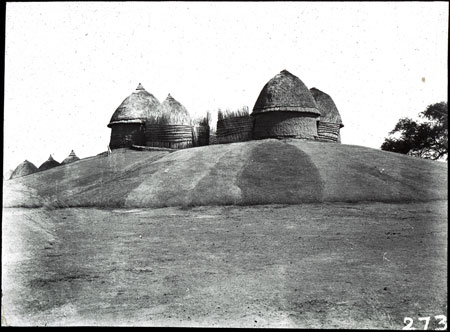Shilluk king's homestead

82 x 82 mm | Lantern slide glass
MountDimension:
82 x 82 mm
Date of Print:
Unknown
Same Image As:
1967.26.189
Previous Other Number:
V.e.44 (273)
Accession Number:
1967.26.190
Description:
The homestead mound (Aturwic) of the Shilluk king at Fashoda, with his compound of four huts built on top.
The mound was said to have been built by the tenth king, Tugo.
The Shilluk king (Reth) was a highly important figure in Shilluk society, thought to be the incarnation of the nation founder Nyakang.
Photographer:
Charles Gabriel Seligman
Date of Photo:
1910
Region:
[Southern Sudan] Upper Nile Fashoda
Group:
Shilluk
Publication History:
Contemporary Publication - Reproduced as Plate VI Fig.1 (facing page 48) in C.G.
& B.
Seligman's
Pagan Tribes of the Nilotic Sudan
(London, Routledge 1932), with the caption "Fashoda, Aturwic" [CM 2/9/2005]
PRM Source:
London School of Economics and Political Science
Acquired:
Donated 1967
Other Owners:
C. G. Seligman slide collection
Class:
Shelter , Settlement
Keyword:
Building House
Documentation:
Manual Catalogue in Related Documents File
Primary Documentation:
Accession Book Entry - [1967.26] THE LONDON SCHOOL OF ECONOMICS AND POLITICAL SCIENCE, HOUGHTON STREET, ALDWYCH, LONDON, W.C.E.
PER MR ANTHONY FORGE - SUDAN.
Box containing 309 lantern slides (3 1/4” x 3 1/4”) made from photographs taken by the late Professor C.
G.
SELIGMAN in various parts of the SUDAN.
All slides numbered and labelled.
Catalogue in file (“Seligman Slide Collection”).
Additional Accession Book Entry - [in pencil] 18 Parks Rd.
Manual catalogue entry (thermofax catalogue copy in folder '27-06 Seligman Slide Collection') - "V.e.44. Fashoda King's house"
Note on lantern slide ms ink - "V.e.44. Fashoda King's house" & ms note in neg - "273"
Manual catalogue entry (thermofax catalogue copy in folder '27-06 Seligman Slide Collection') - "V.e.44. Fashoda King's house"
Note on lantern slide ms ink - "V.e.44. Fashoda King's house" & ms note in neg - "273"
Other Information:
Ethnographic context - In C.G.
& B.
Seligman's Pagan Tribes of the Nilotic Sudan (London, Routledge 1932), page 47, they note that 'The king and his many wives live at Fashoda.
The king's dwelling when we saw it in 1910 consisted of four huts, no better built than those of his people and lacking the ostrich-egg and spear of the royal shrines.
They stood well above the rest of the settlement on an artificial mound, called Aturwic (shown on Pl.VI) , which may have been some ten feet high, and was said to have been built by the tenth king, Tugo.' [Chris Morton 18/10/2004]
Recorder:
Christopher Morton [18/10/2004] [Southern Sudan Project]

